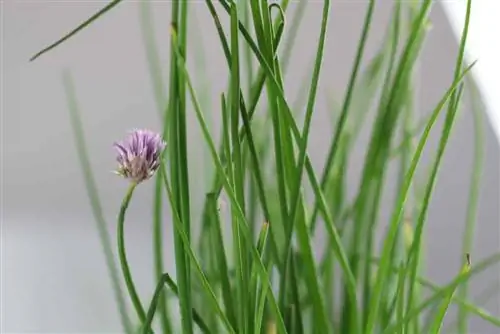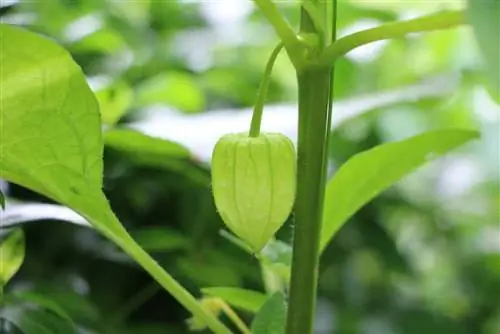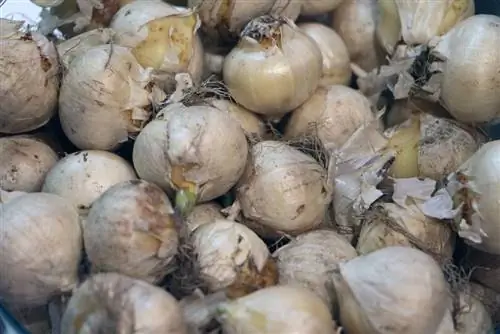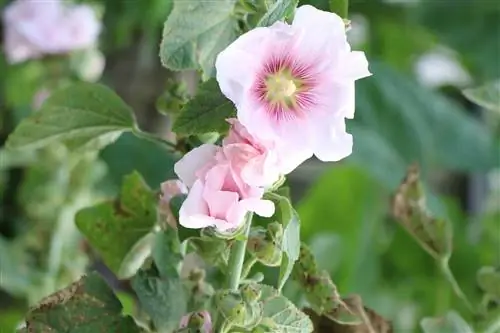- Author admin [email protected].
- Public 2023-12-17 03:39.
- Last modified 2025-06-01 06:48.
Hollyhocks thrive as biennial or perennial summer flowers that conjure up a romantic flair in your garden with their colorful calyxes. In the bucket, the picturesque beauties are a welcome guest on the summer balcony. Regardless of their name, farmer's roses are not true roses, but are classified as mallows. The herbaceous growth has a particular impact on pruning care and overwintering. Don't puzzle over the question of how to properly cut and overwinter your Alcea rosea. This guide has all the answers.
What does two-year growth mean for cutting?
With their two-year growth, hollyhocks stand out among summer flowers. Since this species-specific behavior has an impact on pruning, we briefly summarize the characteristic features of this floral life cycle below:
There are two growing seasons for hollyhocks between their growth as seedlings and the formation of seeds. In this respect, the term two-year growth is misleading because it is not two calendar years. Before the climatically unfavorable winter period, the plants only develop their roots and a native rosette of leaves. In this way, nutrient reserves are created for the second vegetation phase the following summer. When temperatures rise in spring, the rosette of leaves sprouts into a taut, upright stem on which the flowers then develop.
Biennial plants usually die after the seeds ripen. As these instructions explain in more detail, this is not necessarily the case with hollyhocks. At least the unfilled varieties can bloom in the following years just as often as perennials after professional pruning.
The perfect time
As the explanation of the two-year growth behavior shows, the basal leaf rosette has an important task in the planting year. Cutting off the leaves before the onset of winter usually means total loss of flowers the following year. Hollyhocks remain unaffected by scissors in the first year.
The best date for pruning a farmer's rose is from the second year after the end of the flowering period. The less energy an Alcea rosea has to invest in the energy-sapping seed formation, the better the prospects of another flower festival next summer.
Tip:
Hollyhocks are completely non-toxic and do not have any sharp thorns like many real roses. Therefore, Alcea rosea are perfect for transforming the family garden into a summer sea of flowers.
Cut correctly - this is how it works
Hollyhocks make it easy for your gardener to prune them professionally. At the end of the flowering period, the strong stem is cut off along with the withered inflorescences. Under normal weather conditions this is the case in September or October. How to do it right:
- Pick up sharp, clean scissors or a freshly sharpened knife
- Grip the stem with one hand and stabilize it
- Cut off the main shaft with the other hand
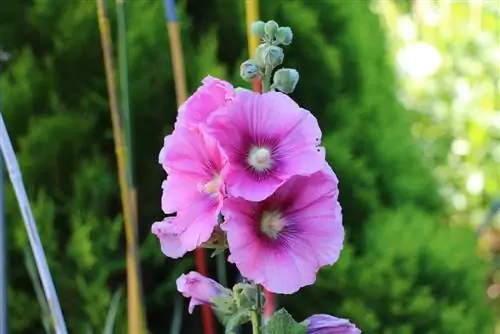
Ideally, you should make the cut just above the rosette of leaves. This remains as a natural winter protection until early spring. In February, cut off the now unsightly, drawn-in leaves close to the ground to make room for the fresh shoots.
Cleaning prevents semination
The propagation strategy of Alcea rosea focuses on self-seeding. For this purpose, the magnificent, pollinated calyxes turn into split fruits with countless seeds after flowering. Where these fall on fertile soil, rosettes of leaves often grow in the same year, from which additional farmer's roses later emerge. Such an invasive urge to spread is not always in the gardener's best interests. How to effectively prevent semen:
- Remove wilted flowers from the stem as early as possible
- To do this, grasp the hairy flower stalk with your fingers
- Bend to the side and do not tear off
- Alternatively, cut off the flower stem with small scissors
Since the hollyhock gradually opens its flowers from bottom to top, a premature cut of the main stem removes a large number of unopened buds and radically shortens the flowering time. It is therefore worth cleaning out every single flower if self-sowing is undesirable in the garden.
Tip:
On hollyhocks in a pot on the balcony, there is no need for time-consuming cleaning of withered flowers, as long as the dried petals do not affect the appearance. Here it is sufficient to cut off the stem in autumn.
Is Alcea rosea hardy?
Anyone who has been able to enjoy the lavish blooms of hollyhocks for a summer will no longer want to be without the magnificent flowers in the bed and pot. The question of winter hardiness is therefore obvious. Specialist retailers promote Alcea rosea as a plant in winter hardiness zone Z3. This assignment implies a basic frost hardiness between -34.5 and -40.1 degrees Celsius.
Whether your hollyhocks actually survive severe frost unscathed depends on the local conditions in your garden. The winter hardiness of farmer's roses suffers noticeably in locations exposed to wind or in compacted, moist soil. Likewise, a sudden drop in temperature from plus to minus degrees of more than 10 degrees Celsius can undermine winter hardiness.
Furthermore, winter hardiness only refers to the rhizome, which is located deep in the ground. The herbaceous plant parts on the surface die off completely after the first nights of frost. In contrast, the leaf rosette as a sprout section is better equipped for cold.
Instructions for overwintering in the bed

So that the leaf rosette overwinteres he althily during the planting year, it should receive light winter protection in late autumn. The taproots also benefit from this, as they sometimes do not reach deep enough shortly after planting to withstand severe frost nights. In harsh winter locations, these precautions also make sense in subsequent years:
- In the year of planting, cover the root disc and leaf rosette with leaves and brushwood
- Do the same in the following years after pruning in autumn
- Alternatively, cover the planting site with breathable and translucent fleece
Since the basal rosette continues to evaporate water during the cold season, the plant is threatened by drought stress in the event of clear frost. During a dry winter without snow or rain, water your hollyhock rosettes on mild days.
Tip:
Fertilization with potassium-rich comfrey manure at the end of July/beginning of August strengthens the winter hardiness of hollyhocks. Potassium lowers the freezing point in cell water and strengthens the cell walls against the stresses caused by repeated changes between thaw and frost weather.
Overwintering hollyhocks in a pot - this is how it works
The categorization as a winter-hardy plant up to -40.1 degrees Celsius only applies to planted hollyhocks. These drive a deep taproot into the ground, which protects them from bitter frost. In the pot, the root ball of your farmer's roses is unprotected from the winter cold behind the relatively thin walls. Ideally, after pruning, you should move hollyhocks in pots to a frost-free, bright winter quarters. With the following measures you can overwinter Alcea rosea correctly on the balcony:
- After pruning, place the bucket in front of a protective house wall
- Push a block of wood underneath or insulating Styrofoam panels
- Cover the pot with fleece, jute or foil
- The leaf rosette and substrate cover with brushwood and leaves
- Water the root ball every now and then in winter so that it doesn't dry out
In harsh winter locations with significant exposure to wind, prudent gardeners build protective winter quarters for their hollyhocks in pots. For this purpose, the bottom of a large wooden box is lined with bark mulch or leaves. The bucket with the farmer's rose is placed on it.
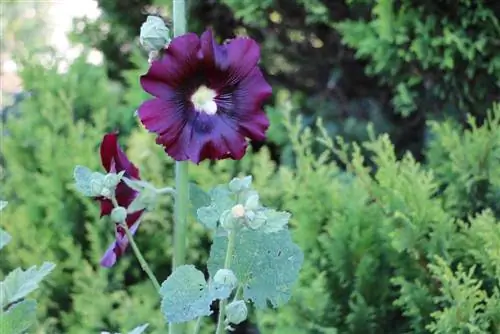
The free space between the pot and the wooden wall is filled with the remaining mulch. As soon as the nighttime temperatures no longer fall below freezing point in spring, the winter protection is removed or a bucket is cleared out.
Conclusion
Pruning hollyhocks correctly is not difficult, even for gardening novices. In the first year, the biennial plant forms a basal rosette of leaves that is not cut. The scissors are only used in the second year at the end of the flowering period by simply cutting off the strong, dead stem just above the basic rosette. Regular cleaning of withered flowers during the flowering period effectively prevents the annoying spread of self-sowing. If this pruning procedure is followed, farmer's roses will bloom again in the following years and will not be satisfied with just one tryst in the summer garden. A light winter protection guides Alcea rosea through the cold season unscathed in the first year. In harsh winter locations, the root disk will continue to be covered with leaves and brushwood after pruning in the next few years. For hollyhocks in pots, the classification as a hardy plant only applies to a limited extent. Without the precautions recommended here, hopes for sustained growth will come to nothing.


